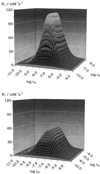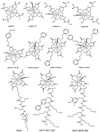Toward the Design of MR Agents for Imaging β-Cell Function
- PMID: 20686642
- PMCID: PMC2913624
- DOI: 10.2174/1568013043357338
Toward the Design of MR Agents for Imaging β-Cell Function
Abstract
The chemistry of Gd(3+)-based MRI agents has advanced considerably during the past decade toward agents with higher relaxivity and agents that respond to physiology and/or metabolism. This review describes various approaches that have been taken toward the development of responsive contrast agents and discusses the importance of fast water exchange for advancement of targeted Gd(3+)-based agents with higher sensitivity. The recent discovery of Eu(3+) complexes having extraordinarily slow water exchange has opened a new avenue in contrast agent design based upon the chemical exchange saturation transfer (CEST) mechanism. These new paramagnetic complexes called PARACEST agents offer new possibilities of imaging biological functions such as tissue pH and metabolite levels. The lower detection limits that may apply to each class of contrast agent (Gd(3+)-based versus PARACEST) are discussed and the extent to which they may be applied to the imaging of β-cells is considered.
Figures




















Similar articles
-
Ytterbium chelated to 1,4,7,10-tetraazacyclododecane-1,4,7-triacetic acid,10-orthoaminoanilide.2011 Nov 26 [updated 2012 Jan 5]. In: Molecular Imaging and Contrast Agent Database (MICAD) [Internet]. Bethesda (MD): National Center for Biotechnology Information (US); 2004–2013. 2011 Nov 26 [updated 2012 Jan 5]. In: Molecular Imaging and Contrast Agent Database (MICAD) [Internet]. Bethesda (MD): National Center for Biotechnology Information (US); 2004–2013. PMID: 22238803 Free Books & Documents. Review.
-
Responsive MRI agents for sensing metabolism in vivo.Acc Chem Res. 2009 Jul 21;42(7):948-57. doi: 10.1021/ar800237f. Acc Chem Res. 2009. PMID: 19265438 Free PMC article. Review.
-
Eu-1,7-Bis(2-(methylene benzyloxy ether)-acetic acid) acetamide-4,10-bis(acetamidoacetic acid)-1,4,7,10- tetraazacyclododecane.2009 Feb 19 [updated 2009 Mar 10]. In: Molecular Imaging and Contrast Agent Database (MICAD) [Internet]. Bethesda (MD): National Center for Biotechnology Information (US); 2004–2013. 2009 Feb 19 [updated 2009 Mar 10]. In: Molecular Imaging and Contrast Agent Database (MICAD) [Internet]. Bethesda (MD): National Center for Biotechnology Information (US); 2004–2013. PMID: 20641846 Free Books & Documents. Review.
-
Eu-chelate anti-fibrin antibody-conjugated perfluorocarbon nanoparticles.2008 Jan 17 [updated 2008 Feb 20]. In: Molecular Imaging and Contrast Agent Database (MICAD) [Internet]. Bethesda (MD): National Center for Biotechnology Information (US); 2004–2013. 2008 Jan 17 [updated 2008 Feb 20]. In: Molecular Imaging and Contrast Agent Database (MICAD) [Internet]. Bethesda (MD): National Center for Biotechnology Information (US); 2004–2013. PMID: 20641487 Free Books & Documents. Review.
-
Advantages of paramagnetic chemical exchange saturation transfer (CEST) complexes having slow to intermediate water exchange properties as responsive MRI agents.NMR Biomed. 2013 Jul;26(7):829-38. doi: 10.1002/nbm.2874. Epub 2012 Oct 11. NMR Biomed. 2013. PMID: 23055299 Free PMC article. Review.
Cited by
-
Alternatives to gadolinium-based metal chelates for magnetic resonance imaging.Chem Rev. 2010 May 12;110(5):2960-3018. doi: 10.1021/cr900284a. Chem Rev. 2010. PMID: 20397688 Free PMC article. Review. No abstract available.
-
T2 exchange agents: a new class of paramagnetic MRI contrast agent that shortens water T2 by chemical exchange rather than relaxation.Magn Reson Med. 2011 Dec;66(6):1697-703. doi: 10.1002/mrm.22938. Epub 2011 May 23. Magn Reson Med. 2011. PMID: 21608031 Free PMC article.
-
Novel Gd nanoparticles enhance vascular contrast for high-resolution magnetic resonance imaging.PLoS One. 2010 Sep 30;5(9):e13082. doi: 10.1371/journal.pone.0013082. PLoS One. 2010. PMID: 20927340 Free PMC article.
-
Lanthanide(III) complexes of tris(amide) PCTA derivatives as potential bimodal magnetic resonance and optical imaging agents.Chemistry. 2009 Dec 7;15(47):13188-200. doi: 10.1002/chem.200901095. Chemistry. 2009. PMID: 19882595 Free PMC article.
-
Solid state and solution dynamics of pyridine based tetraaza-macrocyclic lanthanide chelates possessing phosphonate ligating functionality (Ln-PCTMB): effect on relaxometry and optical properties.Inorg Chem. 2009 Dec 21;48(24):11767-78. doi: 10.1021/ic901779k. Inorg Chem. 2009. PMID: 19908824 Free PMC article.
References
-
- Sigel A, Sigel H. The Lanthanides and Their Interrelations with Biosystems. Vol. 40. New York: Dekker; 2003.
-
- Woods M, Kovacs Z, Sherry AD. J. Supramol. Chem. 2002;2:1.
-
- Caravan P, Ellison JJ, McMurry TJ, Lauffer RB. Chem. Rev. 1999;99:2293. - PubMed
-
- Merbach AE, Toth E. The Chemistry of Contrast Agents in Medical Magnetic Resonance Imaging. New York: Wiley; 2001.
-
- Woods M, Zhang S, Von Howard E, Sherry AD. Chem. Eur. J. 2003;9:4634. - PubMed
Grants and funding
LinkOut - more resources
Full Text Sources
Miscellaneous
